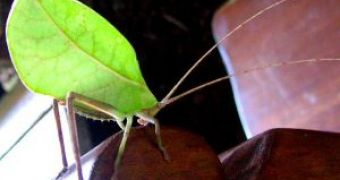In temperate zones, we are pleased in the quiet summer nights by the chorus of night insects, most of the songs belonging to cricket and grasshoppers.
Well, in a tropical environment you won't be pleased anyway by the crowds of the creepy and often venomous insects. Moreover, you won't hear the crickets. Because they may produce ultrasounds, which human ears cannot detect.
A recent study found that one of the crickets inhabiting tropical rainforests can actually produce the highest-frequency ultrasound of any known insect. These extraordinary sounds are emitted by the lonely male Arachnoscelis from the Katydidae family, which makes its presence known with a burst of intense sounds. In fact, Members of Orthoptera Order (cricket, grasshopper and locusts) are famous for their ability to sing, and most emit chirps at frequencies humans can hear.
But some katydid species produce ultrasonic chirps by rubbing their forewings together, pushing a scraper on one wing across a series of pegs on the other. But Arachnoscelis species use a different method.
Fernando Montealegre-Z and Glenn Morris from the University of Toronto in Canada found in their investigation that they chirp at 130 kilohertz, which is too high a frequency to be generated by merely rubbing the wings together.
The team got katydid specimens from the Colombian rainforest, and - while measuring their chirps - they looked at their wings with an electron microscope. This way they discovered that the wings are rubbed against each other and the scraper wedges itself behind one of the pegs, provoking a distortion. When the scraper is freed, it springs back into shape, emitting an ultrasound. "By using elastic energy, the animal saves metabolic energy, as the muscles do not contract at an almost impossible speed," says Montealegre-Z.
Other well known animals that produce ultrasounds are bats and cetaceans (whales and dolphins).

 14 DAY TRIAL //
14 DAY TRIAL //